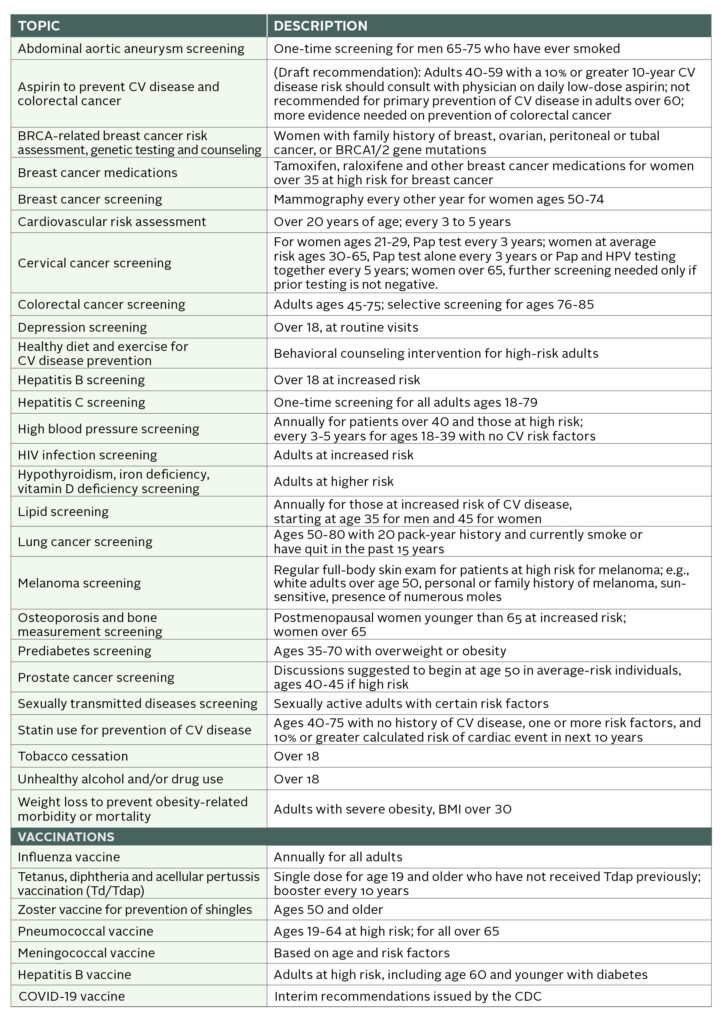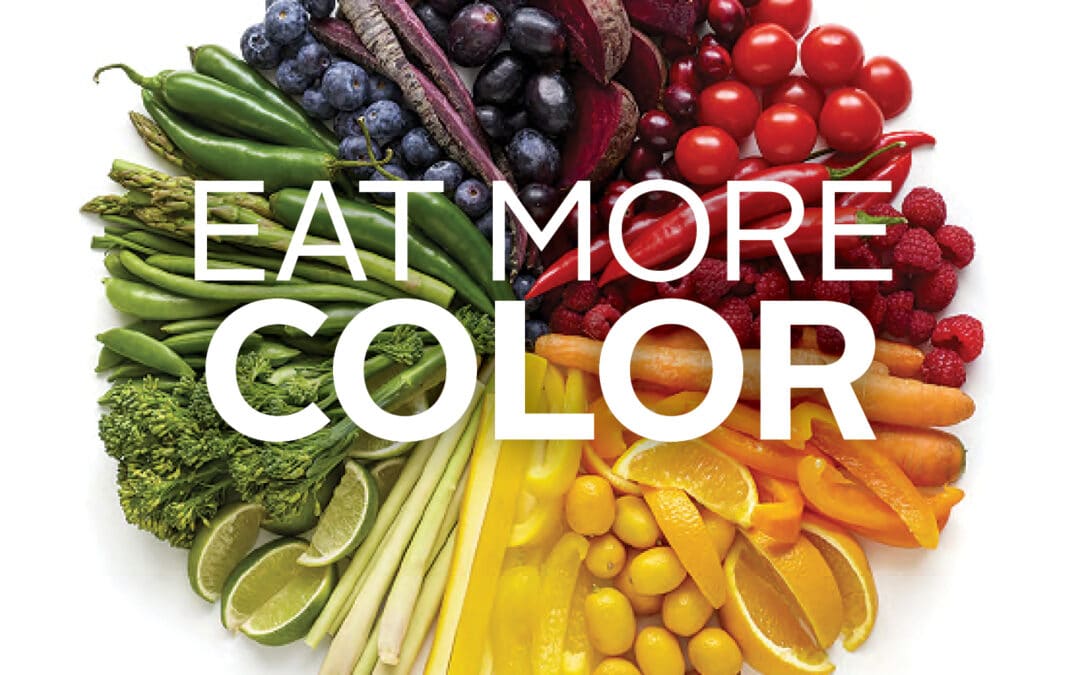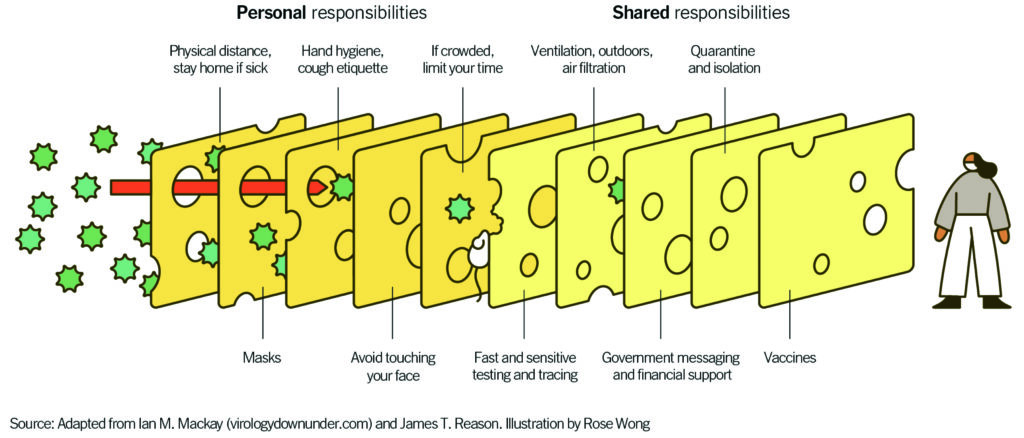
by Specialdocs Consultants | Dec 15, 2021 | Patient News, Wellness
In the spirit of starting 2022 with healthy intention, we’ve taken a page from the U.S. Preventive Services Task Force (USPSTF) latest recommendations, long considered the gold standard for clinical preventive services, and prepared the following proactive guide to staying well in the new year.
Back in 1903, Thomas Edison predicted where we were headed: “The doctor of the future will give no medicine but will instruct his patient in the care of the human frame, in diet, and the cause and prevention of disease.”
While we have yet to reach the future envisioned by Edison, preventive care, relegated to the back seat during the pandemic, is in full gear once again.
Since 1984, the USPSTF team of volunteer, independent experts in internal medicine, family medicine, pediatrics, behavioral health, obstetrics/gynecology and nursing has conducted rigorous assessments of the scientific evidence for the effectiveness of a broad range of preventive screening, counseling and medications. Their findings, published in the Journal of the American Medical Association, laid the foundation for preventive medicine in primary care, from when to get your first colonoscopy to whether an aspirin a day is really the best way to keep a heart attack at bay.
A number of USPSTF recommendations have changed significantly over the years, guided by evolving science and clinical experience. In 2021, these changes included lowering the screening age for diabetes from age 40 to 35, lowering the age for colorectal cancer screening from age 50 to 45, and strongly discouraging people over 60 from taking a low-dose aspirin each day to prevent a first cardiovascular (CV) event. As recently noted by the advisory board, this doesn’t represent a flip-flop or misfire, but rather necessary updates based on new research. So, for example, when the latest evidence showed the increased risk of gastrointestinal or brain bleeds in certain populations from taking a daily aspirin to prevent CV disease, the panel reviewed, reconsidered and drafted a revision to its 2016 recommendation. Similarly, when data pointed to the incidence of diabetes increasing at age 35 and the benefits of lifestyle interventions for reducing progression from prediabetes to the more serious type 2, the USPSTF revised accordingly.
What’s on the radar for the USPSTF? Recommendations being studied now for potential updates include statin use for the prevention of CV disease; vitamin, mineral and multivitamin supplementation to prevent CV disease and cancer; behavioral counseling interventions for prevention of CV disease in low-risk adults; hormone therapy to prevent chronic conditions in postmenopausal women; effectiveness of screening for depression, eating disorders, obstructive sleep apnea, skin cancer, osteoporosis, glaucoma and atrial fibrillation; and a comparison of breast cancer screening methods. Stay tuned for new developments.
An Ounce of Prevention
Following are the latest USPSTF preventive medicine recommendations, intended for people without symptoms of the disease. As always, please consult with your healthcare provider for guidance based on your personal health situation.

by Specialdocs Consultants | Dec 15, 2021 | Nutrition, Patient News, Wellness
Eating Your Fruits and Veggies May Help Reduce the Risk of Chronic Disease
Fill your plate with a vibrant, colorful array of fruits and vegetables for a naturally delicious way to meet your daily requirement of vitamins, minerals and nutrients. Plant foods contain thousands of natural compounds called phytonutrients, which may have anti-inflammatory benefits that can help reduce the risk of chronic diseases. Every color has a contribution to make – aim for a few different ones each day, and enjoy the entire spectrum.
Red and pink:
These fruits and vegetables are an abundant source of the carotenoid lycopene, which may help balance free radical activity in the body, offering protection against prostate cancer and heart and lung disease. Additional picks: red onions, persimmons and raspberries.
- beets
- cherries
- cranberries
- pink grapefruit
- pomegranates
- radicchio
- red radishes
- red apples
- red grapes
- red peppers
- red potatoes
- rhubarbs
- strawberries
- tomatoes
- watermelons
Orange and yellow:
Enjoy an extra boost of beta cryptoxanthin, which supports intracellular communication and may help prevent heart disease. Orange and yellow fruits and vegetables also contain vitamin C and carotenoids, including beta-carotene, which is associated with promoting healthy vision and cell growth. Additional picks: pomelos, turmeric root and star fruit.
- acorn squash
- butternut squash
- apricots
- cantaloupes
- carrots
- corn
- grapefruit
- lemons
- mangoes
- nectarines
- oranges
- orange peppers
- papayas
- peaches
- pineapples
- pumpkins
- summer squash
- sweet potatoes
- tangerines
- yams
- yellow apples
- yellow peppers
- yellow squash
Green:
These are some of the healthiest fruits and vegetables, rich in chemicals like sulforaphane, isothiocyanates and indoles, which may inhibit the action of carcinogens. Dark green and leafy vegetables have the highest concentration of both antioxidants and fiber. They’re also packed with potassium, lutein, isothiocyanates, isoflavones and vitamin K, which can be important for vision, bone and blood health. Greens like kale have as much calcium as milk. Additional picks: Swiss chard, arugula, zucchini, edamame, alfalfa sprouts and green herbs (mint, rosemary, sage, thyme and basil).
- artichokes
- asparagus
- avocados
- bok choy
- broccoli
- Brussels sprouts
- celery
- collard greens
- cucumbers
- green beans
- green cabbage
- green grapes
- green onions
- green peppers
- kale
- kiwis
- leeks
- limes
- mustard greens
- okra
- pears
- peas
- romaine lettuce
- snow peas
- spinach
- sugar snap peas
- watercress
- zucchini
Blue and purple:
Anthocyanins – powerful antioxidants that may help delay cellular aging, block the formation of blood clots and boost urinary tract health – abound in these fruits and veggies. Additional picks: beetroot, radishes and purple cabbage.
- blackberries
- blueberries
- black currants
- dates
- eggplants
- grapes
- plums
- prunes
- purple figs
- raisins
White:
These foods may not be as brightly hued as the others, but they shine with valuable phytonutrients. These include the potentially anti-tumor properties of allicin and quercetin, found in garlic and onions; the healthy compound sulforaphane in the cruciferous cauliflower; and immune-supporting selenium in mushrooms. Additional picks: leeks, white beans (cannellini, navy beans, lima beans, soybeans), lychees, white peaches and daikon radish.
- bananas
- cauliflower
- garlic
- Jerusalem artichokes
- mushrooms
- onions
- potatoes
- parsnips
- shallots
Sources: American Heart Association, Rush.edu, Harvard Health
ul.multi-col {column-count: auto;column-gap: 2em;column-width: 18ch;}

by | Sep 11, 2021 | Medications, Patient News
Pandemic Sparks Promising Future for Clinical Trial Speed and Flexibility
Like wartime medicine, the pandemic inspires and challenges medical innovation.
The silver lining of the pandemic is the reinvigorated sense of urgency breaking down
cumbersome and expensive barriers to the FDA’s phased approval process. While the research- lab-to-patient-arm trials for the highly successful COVID-19 vaccines famously moved the traditional pace to warp speed, other critical and life-altering medicines, devices and therapies also broke through during this period.
To be clear, the current surge of medical innovation through clinical trials in immunology, cardiology, multiple sclerosis, oncology and more, is not the result of a rush-to-market panic. All necessary and appropriate testing protocols to ensure quality are still being achieved, but at a more expedient pace in many cases. This is the good news.
“In times of crisis, we can accelerate the development and review process,” explains Andrew Badley, MD, infectious disease specialist, Mayo Clinic. “Throughout the pandemic, many of these steps were accelerated. No steps were skipped. It was just the amount of effort that went into the development and the review that was increased.”
Of course, there is also some not-so-good news about clinical trials today. During the pandemic, the number of new studies launched dropped by as much as 57 percent, according to Trials Journal, and the overall completion rate of clinical trials decreased between 13 and 23 percent globally. Shifting research priorities (11 percent of studies shifted to pandemic-related trials in 2020) and initial challenges in recruiting and following up with volunteer patients during the global lockdown contributed to this decrease. Often, a clinical trial is tethered to an academic medical center with participants centered in one geographical area, limiting volunteer pools and access.
However, the future speed and flexibility of clinical trial protocols is very promising, reflecting the long-term viability of alterations made to the fabric of patient care and research during the pandemic. Some of the new flexibility that is being assessed and considered for permanent use includes:
- Telemedicine. While telemedicine has been available for years, the lockdown most certainly fast-tracked adoption among researchers, regulators, physicians and patients. Clinical trial investigators can now use telemedicine for many patient check-ins, saving time and broadening the geography of volunteer pools. Dr. Ray Dorsey, a neurologist at the University of Rochester, noted in a recent article that his virtual clinical study of
genetic predisposition to Parkinson’s disease moved forward more quickly amid the pandemic, spurred by a rising number of online enrollments.
- Delivery. Like specialty pharmacies and physicians during lockdown, clinical trial investigators are now allowed to deliver trial medicine to volunteers.
- Remote Access. Volunteer participants are able to use online platforms for completing consent forms, and they can often visit their local physician for basic assessments. Some
trials also require less frequent check-ins, which can be important in recruiting volunteer patients. The growing number of smartphone-enabled applications that provide measurement of critical physiologic variables means patients don’t need to continually return to the hospital or clinic for tests during the trial. For instance, an entirely remote study testing vitamin D for treating COVID-19 and preventing transmission is being conducted by Brigham and Women’s Hospital; participants obtain their own blood samples with a finger prick, dot the blood drop onto filter paper supplied to them and mail it back.
The Clinical Trial Explainer
In the United States, the Food and Drug Administration (FDA) directs and approves all prescribed medicines, diets, diagnostics, devices and therapies. Clinical trials are the part of research that determines whether a medical intervention should be moved, or “translated,” from the lab to routine patient care. At each phase along the way, the team must answer different questions about safety, efficacy (whether the intervention works as intended) and whether there might be better options available. The current clinical trial journey to FDA approval, shown below, can take years, a mountain of paperwork and millions of dollars – there is room for improvement.
- Preclinical phase establishes the pharmacological profile and determines toxicity on at least two animal species.
- Phase I, a short study of 20 to 80 healthy people to determine safe treatment and dosing.
- Phase II, a larger-scale study of targeted patients to determine treatment effectiveness and identify side effects; can take months to years to complete.
- Phase III compares the trial intervention with existing therapies; requires several years of multiple data collection check-ins and comparisons. About 1 in 15 won’t make it past phase III.
- FDA Review and Approval
- Phase IV follows patients after therapy approval to ensure the intervention is working and prove the long-term benefits outweigh any risks or side effects.

by | Sep 11, 2021 | Nutrition, Patient News, Wellness
How to Pare Down Protein & Cut Back Carbs
Inspired by a belief that our diets can be redefined to integrate both healthier eating and environmental responsibility, Menus of Change encourages a meaningful “flip” in the emphasis on animal proteins and highly processed carbohydrates to an emphasis on highly appealing alternatives.
Menus of Change, a collaboration of the Harvard T.H. Chan School of Public Health and the Culinary Institute of America (CIA), authors a creative approach to enjoying delicious, nutritional and sustainable foods: “The Protein Flip” and its companion, the
“Carbohydrate Flip.”
The Protein Flip, introduced in 2016, laid the groundwork for the Menus of Change health- oriented methodology, stating, “Higher intake of red meat, irrespective of its total fat content, increases risk of heart disease, stroke and diabetes when compared to poultry, fish, eggs, nuts, or legumes.”
The Menus of Change solution was to challenge chefs in every setting to place meat, poultry and seafood in a supporting role or as a side and make vegetables and plant proteins the stars – for example, burger blends composed of primarily mushrooms, other vegetables, grains or legumes; surf and turf reimagined as seafood with bountiful vegetables and only a bite or two of meat; use of tapas, mezze and other plant-forward small plate replacements for entrees. The public response was immensely gratifying, spurring further innovation and the mainstreaming of vegan options, such as lentil, barley and black bean burgers or wild rice polenta burgers made with mushrooms, carrots and leeks.
Building on their successful work with proteins, the collaborative is now developing a complementary program centered on advancing carbohydrate quality on the American plate. “From fluffy pancakes to soft hamburger buns, refined, fast-metabolizing carbohydrates are still found in many a diet and are contributing to the rise in diet-linked chronic conditions such as
diabetes and heart disease,” according to a recent Menus of Change summit panel discussion headed by Sarah Schutzberger, RD, CSO (certified in oncology nutrition). “In large part because of our food choices, scientists project that 75 percent of chronic diseases are attributable to diet and lifestyle.”
A substantial emphasis on whole, minimally processed carbohydrates can help change the trajectory, beginning with these flips described by the panel:
- Take on the Three Pleasures challenge: Create a delicious dessert using dark chocolate, nuts, and fresh-cut or dried fruit. “Instead of forcing a choice between a whole slice of cheesecake with a single strawberry as garnish or a plain bowl of berries, enjoy a dessert made from a healthy market basket that includes dark chocolate, fruit, whole grains, nuts and yogurt,” advised Greg Drescher, Culinary Institute of America.
- Look to world food cultures for inspiration:
- Mediterranean region: “This type of cooking features a healthy fat versus a low fat approach to diet, with olive oil as the foundation of flavor,” said Drescher. Try tabouli, made of cracked bulgur wheat, chopped parsley and olive oil, or a salad made with hydrated, whole-grain barley rusks, topped with chopped tomatoes and fresh feta cheese and tossed with olive oil. Also important: improve the health profile of pasta by using a whole-grain type and cooking al dente to make it a source of slower-releasing carbohydrates.
- France: The niçoise salad suggests ways to include potatoes in limited amounts by pairing with green beans and other vegetables, hard-boiled egg, and a light vinaigrette for a slow-metabolizing lunch.
- Asia and India: Try a salad featuring soba noodles made from buckwheat flour; a Buddha bowl with foundational ingredients that include legumes, fresh vegetables and plant proteins, paired with small amounts of salmon or roasted tofu; and whole-grain flatbreads.

by | Sep 11, 2021 | Medical Conditions, Patient News, Wellness
From Boosters & Breakthroughs to Vaccines & Variants: Where Do We Go From Here?
The following reflects an 8/24/2021 discussion; please check the CDC website for real-time updates as the situation continues to evolve.
Their answers may not land lightly, but epidemiologist Jodie Guest, PhD, and drug development expert Michael Kinch, PhD, have been immersed in examining COVID-19 since its first stirrings in early 2020. They share an informed look at the road ahead for us all.
State of Concern
Noting more than 39 million COVID-19 cases nationwide, (as of 9/2/21) Guest projects this will continue to rise rapidly and eclipse one million a week. While “hot spots” for outbreaks clearly correspond to the country’s most lightly vaccinated locales, the impact of the delta variant is being felt in virtually every state. “There’s almost nowhere you can go in the U.S. that you don’t need to be masked indoors, even if vaccinated,” she says. The progressive increase in vaccinated patients with COVID-19 in European hospitals is also troubling, says Kinch, a potential harbinger of what is to come for the U.S.
However, what’s driving the surge is not cases among the vaccinated, known as “breakthroughs.” It’s a term Guest would like to eliminate permanently, given its negative connotation regarding vaccine efficacy. “These type of infections are still rare. More than 90% of those hospitalized with COVID-19 are unvaccinated.” She points out that while viral loads in patients with COVID-19 are the same for vaccinated and unvaccinated patients in the first few days of illness, they drop much faster and further in the vaccinated.
The vaccine, contends Kinch, was never intended to eliminate all possibility of getting COVID-19. “It’s not a suit of armor,” he says, “because no vaccine ever provides 100% protection. But we know they work incredibly well to prevent you from getting very sick or dying.”
The FDA’s recent approval of the Pfizer mRNA vaccine, with Moderna approval expected to follow soon, is pivotal, says Guest, in helping launch vaccination requirements at businesses, schools and other locations. “Don’t underestimate the importance of this approval in providing support for mandates that will protect all of us,” she says. “Recognize that in the entire history of vaccines, there has never been a set more studied than the ones we have now.”
Adds Kinch, “With the enormous amount of data gathered on the vaccines’ efficacy and safety, those who think of themselves as vaccine hesitant may more accurately be described as vaccine resistant.”
Third Doses and Boosters
The recent approval of a third dose of Pfizer or Moderna for immunosuppressed patients who didn’t build sufficient immunity from the first two doses applies to just 3% of the adult population. For everyone else (with the exception of pregnant women), a booster shot six to eight months after the initial series is being considered for approval.
“Right now, that’s how long we believe we can go without significantly diminished immunity,” says Guest. Antibody tests are not proven to be an accurate measure of protection from COVID-19, says Kinch, because the antibody levels vary by individual.
If you received Pfizer or Moderna initially, choose the same for a booster. Notes Kinch: “There’s no difference between these two vaccines—one is not better than the other.” In fact, some studies show no impact on efficacy from switching brands, he says; Johnson & Johnson data is yet to come.
And where does the flu shot fit in this fall? Absolutely essential, both agree, with the only caution that a two-week separation between the two vaccines may be recommended by some healthcare providers to avoid triggering a hyperactive immune response.
Protecting our Children
The best way to keep youngsters under 12 safe is ensuring that everyone around them is vaccinated, says Guest.
“Teachers, caregivers, babysitters and others should be vaccinated, or fully masked whenever they’re with children,” she advises. A different dose is being tested for 5- to 12-year-olds, with approval possible later this year.
The Next Wave of Variants?
While not identified by the Centers for Disease Control (CDC) as a “high concern,” Kinch admits that the lambda variant worries him primarily because not enough is known about its ability to resist vaccines. “One view is that the COVID-19 spike protein can only mutate to a certain point, and if that’s true, lambda could be the end of the virus. The other view is that we don’t know if it stopped mutating,” he says.
“We’re not defenseless, though,” counters Guest, “because we can keep it from getting here by having COVID-19 not circulating in communities. Greater numbers of vaccinated people will prevent us from getting whatever variant might follow delta.”
Stay Safe and Well
One of last year’s most popular signoff lines takes on new resonance as our experts advise on what that now means for the vaccinated in fall 2021.
Mask Up, Indoors and Out.
Masks are increasingly needed outside in crowded areas. Indoors, remember that while a soft, comfortable cloth mask protects others from you, if you need extra protection in certain settings, use a KN95 or N95 mask.
Pass on Indoor Dining, Movies, Concerts and Sporting Events.
Also reconsider full-capacity outdoor events with no masking/distancing/vaccine requirements. (As an alternative, order take-out and support virtual events offered by local venues). And avoid getting together in person with those who are not vaccinated.
Reach out to Every Unvaccinated Person you Know.
“The best action we can take is to keep encouraging every unvaccinated person we know to get the shot, now,” advises Guest. “We’re all in the race against variants and need to work together to defeat them as quickly as possible.” Adds Kinch, “It’s unfortunate that the motivations behind much of the messaging has messed up the message itself. Be completely honest about what is known and not known about the vaccine.”
The Swiss Cheese Respiratory Pandemic Defense.
 “Layering prevention messages is crucial because the delta variant has made the holes in the Swiss cheese slice of the vaccine just a bit bigger,” says Guest. “Now masks are more crucial than ever before.”
“Layering prevention messages is crucial because the delta variant has made the holes in the Swiss cheese slice of the vaccine just a bit bigger,” says Guest. “Now masks are more crucial than ever before.”
Dr. Jodie Guest is professor and vice chair of the Department of Epidemiology, Emory University, Atlanta, and award-winning leader of Emory’s Outbreak Response Team for COVID-19.
Dr. Michael Kinch is associate vice chancellor and founder/director of the Center for Research Innovation in Biotechnology and the Center for Drug Discovery at Washington University, St. Louis.
by Specialdocs Consultants, LLC | Apr 24, 2021 | COVID-19, Patient News

On April 23rd, the pause on using J&J’s COVID-19 vaccine in the U.S. was lifted. Click here to see the CDC/FDA official statement. For more information, click here to view or download a PDF of the CDC recommendations.
Please continue to check the CDC website for the latest vaccine information.
The post J&J Vaccine Update: CDC and FDA Recommend Use of J&J’s Janssen COVID-19 Vaccine Resume appeared first on Specialdocs Consultants.







 “Layering prevention messages is crucial because the delta variant has made the holes in the Swiss cheese slice of the vaccine just a bit bigger,” says Guest. “Now masks are more crucial than ever before.”
“Layering prevention messages is crucial because the delta variant has made the holes in the Swiss cheese slice of the vaccine just a bit bigger,” says Guest. “Now masks are more crucial than ever before.”
Recent Comments